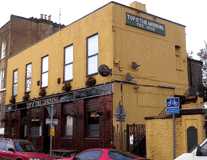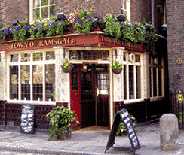_1865445_6c7a7f71.jpg) There is a story that the name Bow was derived from the shape of the arch of the 12th century bridge which spanned the river Lea where Bow flyover now stands. (This illustration shows a later bridge) There is a story that this bridge was commissioned to be built by Queen Matilda after she "had been well washed in the waters" There is a story that the name Bow was derived from the shape of the arch of the 12th century bridge which spanned the river Lea where Bow flyover now stands. (This illustration shows a later bridge) There is a story that this bridge was commissioned to be built by Queen Matilda after she "had been well washed in the waters"  when trying to cross by the ford when on her way to Barking. This bridge is thought to have been the first stone-arched Bridge in Britain and this was 60 years before the first such bridge was when trying to cross by the ford when on her way to Barking. This bridge is thought to have been the first stone-arched Bridge in Britain and this was 60 years before the first such bridge was  built across the Thames in London. During the 14th century there was a chapel on the bridge dedicated to St Katherine and in this there lived a hermit. Chaucer referred to Bow in his Canterbury Tales built across the Thames in London. During the 14th century there was a chapel on the bridge dedicated to St Katherine and in this there lived a hermit. Chaucer referred to Bow in his Canterbury Tales  which takes the name back at least to the 14th century. which takes the name back at least to the 14th century.  In 1600, it was over this bridge that Will Kempe, a leading Shakespearean actor, In 1600, it was over this bridge that Will Kempe, a leading Shakespearean actor,N1+kw~~60_35.JPG) crossed the river Lea on his 9-day Morris Dance from Stepney to Norwich crossed the river Lea on his 9-day Morris Dance from Stepney to Norwich
129 Cadogan Terrace. This pub is specially distinguished because it was connected to the first murder to have taken place on a British railway train. In 1864 Franz Muller robbed a passenger called Thomas Briggs and mortally wounded him. He then pushed him out of the train. He was found still alive by the side of the track, and carried into this pub, but died there some hours later. There is a plaque on the front of the pub commemorating the event. This is not the only East End pub that advertises it's macabre past. See also the Blind Beggar, the Prospect of Whitby and the Town of Ramsgate. Publicans obviously believe that such events attract customers
288 Old Ford Road. Israel Zangwill was a prominent Anglo-Jewish writer. Born in England of Russian Jewish parents, Zangwill started out as a teacher in the Jewish Free School, but soon began to write short stories, then novels and poetry. In some of these he describes the problems of an ancient people coming to terms with life in a modern western country
| Town of Ramsgate .Wapping High Street by Wapping Old Steps. This old pub, which claims to be the oldest on the river, is now a grade II listed building. It dates from 1758 for its first few years it was known as the Prince of Denmark. About this time there were more than 140 ale-houses in Wapping High Street and all with a doubtful reputation. The bar is long and very narrow, because the pub was squeezed in between the path to Wapping Old Steps and the building on its other side. Ship's passengers arrive and departed via these steps. One of the most notorious was Judge Jeffreys, who was called "the hanging judge" because of his cruelty in sentencing the followers of the Duke of Monmouth in his attempted rebellion of 1685. He planned to escape retribution by fleeing the country. While waiting for his ship to depart from Wapping Old Steps, he went to drink in a nearby pub called the Red Cow. Although disguised as a sailor, he was recognised by a man who had once come up before him in court. The latter said that he would never forget a face as evil as that of Judge Jeffreys. The judge was arrested held in the Tower and later executed |
|
|
|
_1865445_6c7a7f71.jpg) There is a story that the name Bow was derived from the shape of the arch of the 12th century bridge which spanned the river Lea where Bow flyover now stands. (This illustration shows a later bridge) There is a story that this bridge was commissioned to be built by Queen Matilda after she "had been well washed in the waters"
There is a story that the name Bow was derived from the shape of the arch of the 12th century bridge which spanned the river Lea where Bow flyover now stands. (This illustration shows a later bridge) There is a story that this bridge was commissioned to be built by Queen Matilda after she "had been well washed in the waters"  which takes the name back at least to the 14th century.
which takes the name back at least to the 14th century.  In 1600, it was over this bridge that Will Kempe, a leading Shakespearean actor,
In 1600, it was over this bridge that Will Kempe, a leading Shakespearean actor,


No comments:
Post a Comment